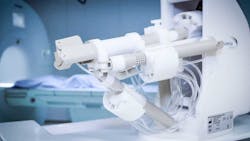Making Beautiful Music Together
Pneumatic technology is associated with high force and speed, while electronic actuators conjure up notions of precision and control. Together, the two technologies broaden the scope for the field of soft robotics.
As Hydraulics & Pneumatics reports today, engineers at UC Riverside have successfully combined the best of both worlds by unveiling an air-powered computer memory that can be used to control soft robots.
Most soft robots are powered by pressurized air and are controlled by electronic circuits. Pneumatic soft robots use pressurized air to move soft, rubbery limbs and grippers, making them superior to traditional rigid robots for performing delicate tasks.
The robot’s performance of “Mary Had A Little Lamb” in this video may not set your toes a-tapping, but it is a great demonstration of the dexterity shown from the research.
The research paper, “A pneumatic random-access memory for controlling soft robots,” is published in the open-access journal PLOS One.
Taking on Prostate Cancer
To make diagnosing prostate cancer more accurate and easier on the patient, a team of engineers at Soteria Medical BV, a Dutch company, went to work designing a Remote-Controlled Manipulator (RCM) that contains five motors. The team wanted a surgeon-controlled robot that would precisely position the biopsy probe to sample suspicious areas of the prostate. The procedure takes place inside an MRI machine, so the surgeon can see real-time imaging of the prostrate and probe, which helps when guiding the probe to its target.
But as Hydraulics & Pneumatics reported recently, this meant the robot could not contain metal, as that would interfere with the MRI. The robot would also have to be compact enough to fit inside the MRI machine along with the patient.
To keep the RCM metal-free, the design team partnered with Festo on pneumatic power to move and position the probe using plastic pneumatic stepper motors controlled by a Festo valve terminal type MPA. The entire RCM is made of MRI-compatible, high-quality plastics. The robotic probe is connected by more than 20 ft of pneumatic tubing to a control unit. This lets the controller be placed in the MRI control room.
About the Author
Bob Vavra
Senior Content Director, Power & Motion and Machine Design
Bob Vavra is the Senior Content Director of Power & Motion and its sister publication Machine Design. Vavra has had a long career in publishing, media and events. He has covered all aspects of manufacturing for the past 20 years and is a regular attendee at events such as IMTS and Hannover Messe. Vavra is also a sought-after webcast moderator and event emcee, and has presided over events in the U.S., Germany and China.

Leaders relevant to this article:
